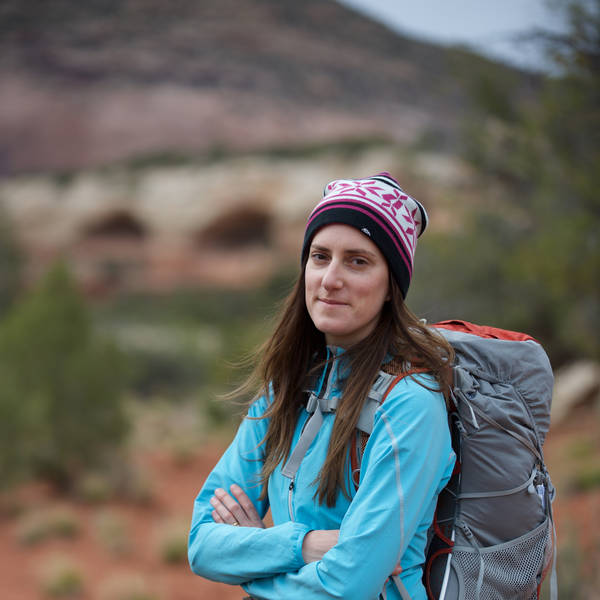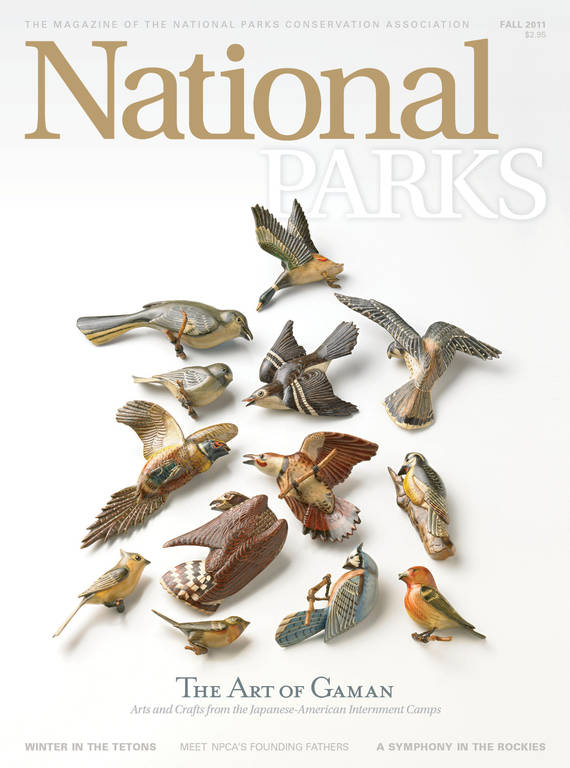Fall 2011
The Visionaries
Nearly 100 years ago, the work of best friends Stephen Mather and Robert Sterling Yard forever endeared the American public to the national parks—and gave birth to NPCA, the organization that would protect them.
On a cool summer evening in 1915, more than a dozen of the country’s most influential men sat around a bonfire at the toes of Mt. Whitney. Among them were a congressman, a railroad executive, a National Geographic editor, and the president of the Natural History Museum.
After a meal of venison and trout served on crisp white linens under the glow of Japanese lanterns, the group lit up cigars, quietly nursed sore muscles, marveled at the stars, and reflected upon their remarkable journey through what are now some of America’s most storied landscapes.
Over the course of 12 days, they had gathered around the living giants of Sequoia National Park, plucked trout from remote streams, dared each other to swim in the icy Kern River, and climbed to the top of Mt. Whitney. But they also witnessed the heart-tugging devastation of overgrazing and other self-absorbed interests run rampant on public lands.
If they were feeling nostalgic, there was good reason. That was precisely what Stephen Tyng Mather, the assistant to the secretary of the Interior and leader of the trip, had hoped for. He brought this esteemed group of men together to endear them to the pressing need for an agency to oversee the national parks—what would one day become the National Park Service. In front of the snapping blaze, Mather stood up—a well-cut figure at six-foot-one—cleared his throat, and capitalized on the opportunity of the moment.
“Well, men, we’ve had a glorious ten days together, and we’ll have a few more before we part in Yosemite,” he began. “[But] the valleys and heights of the Sierra Nevada are just one small part of the majesty of America….Just think of the vast areas of our land that should be preserved for the future.” With his words reverberating throughout the darkness, Mather impressed upon them the utter necessity of a government agency to protect the parks for future generations and from selfish interests before it was too late: “To each of you, remember that God has given us these beautiful lands,” he said. “Go out and spread the gospel.” If Mather’s goal was to convert every one of these men into park advocates, he succeeded.
Though a pivotal moment, this trip was but one part of a national-parks publicity blitz Mather designed with the help of one of his best friends, Robert Sterling Yard, a former newspaper reporter and gifted wordsmith. Back in Washington, D.C., Yard spun tales of the majesty of the national parks for books, dozens of magazine and newspaper articles, and press releases. But the effort had started several years earlier, when Horace McFarland, president of the American Civic Association, sparked a movement to establish a parks agency after he and naturalist John Muir had failed to save the Hetch Hetchy Valley, part of Yosemite that was dammed in 1913. Now, Yard and Mather built upon McFarland’s momentum, hoping to gather the spectacular but disparate beginnings of the national parks into a system that would educate and inspire generations of Americans and set an enduring example for conservation. This friendship also, in short turn, gave birth to another organization vital to the survival of the national parks as we know them today: the National Parks Conservation Association.
Stephen Mather and Bob Yard met as cub reporters for the New York Sun in the 1890s. After Yard served as best man at Mather’s wedding, Mather left the newspaper business to please his new wife, who didn’t think highly of newspapermen who chased politicians and smelled of printer’s ink. Over the next 20 years, Mather applied his marketing genius to the Borax industry, installing it as a staple in every American household through ideas like the now-famous 20 Mule Team brand. He amassed a fortune but still grew restless, itching for a higher purpose.
Wilderness had always inspired Mather. Born in San Francisco, he hiked and rode horses through the mountains and meadows of the Sierras and grew into a strong adventurous man. Tall with piercing blue eyes, prematurely silver hair, and a strong jaw, he combined movie star looks with an intelligence and circumspection that commanded respect. He was also a restless insomniac.
On camping trips in the Sierras, his buddies would wake to find that their air mattresses had been deflated and some devil was clanging pots. Mather had been awake for hours and finally wanted some company.
“He was a Steven Jobs or a Walt Disney,” says Donald Scott, a former ranger at Alcatraz and a Mather historian. “He was a tremendously driven man in the best sense. He believed when you did something, you did it thoroughly.”
During Mather’s wanderings in the mountains, he encountered the famous naturalist John Muir, who spoke of grave threats to the wilderness. In 1914, two years later, Mather was so inspired by Muir’s devotion and horrified by the persistence of loggers eyeing the sequoias of Yosemite that he sent an indignant 26-page missive to Franklin K. Lane, the secretary of the Interior and fellow Berkeley alumnus, detailing the sorry state of the national parks.
Lane famously responded with one sentence: “Dear Steve, if you don’t like the way the national parks are being run, come on down to Washington and run them yourself.”
Wary of dealing with government red tape but keen on pursuing a dear cause, Mather hesitantly accepted the position and moved to the capital. Like a good businessman, he knew he needed to assemble the best help.
If anyone understood the necessity of marketing, it was Mather. At this time, more prosperous American families traveled abroad to see Europe than the treasures of the United States; Mather knew he needed to change public sentiment and install national parks as a fixture in the American imagination.
All this time, Robert Sterling Yard had honed his skills as a newsman and writer in the journalism trenches of Manhattan and had risen to Sunday editor of the New York Herald. He was Mather’s obvious pick, no matter that there was no budget to pay more than a paltry $30 a month for Yard’s salary. Mather paid his $5,000 salary himself. A native New Yorker who claimed that his most intimate knowledge of green space was “Central Park,” Yard was soon utterly infected by Mather’s legendary passion for conservation.
“His fire was indescribable and absolutely unique,” Francis Farquhar, a former president of the Sierra Club and Mather’s close friend, has said, according to Mather’s biography. “Something about his eyes and the way his face changed color when he talked. If he was out to make a convert, the subject never knew what hit him.” For Bob Yard, this passion for national parks conservation would define the rest of his life.
Like Mather, Yard was no wallflower, and perhaps it was the combination of their indomitable energies that accomplished so much—and eventually drove them apart. Yard was a man without the rugged good looks and stature of Mather, but he was blessed with remarkable energy. Though soft-spoken, he clung to strong opinions and occasionally burst into fiery rants.
The time was ripe for such passion. Celebrating our rugged wilderness—or anything uniquely American—appealed to a populace that could readily visit inspiring places thanks to the popularity of automobiles. And with America’s success in World War I, pride and optimism in the country grew just as much as disposable income.
While Mather used his deft political skills and considerable charisma to woo Washington bigwigs—with the help of his assistant, Horace Albright, American Civic Association president Horace T. McFarland, and others—Yard traveled the country and installed the legend of the national parks in American minds through a stream of press releases, hundreds of magazine stories, and books like Glimpses of Our National Parks and National Parks Portfolio, which, naturally, were largely financed by Mather and conveniently landed on the desk of every congressman. The collective efforts paid off: In 1916, the National Park Service was born.
But even before then, Yard had dreamed of establishing a group free of the sticky politicking of government and devoted to promoting the parks as a priceless educational tool. In 1915, he sent out hundreds of letters to university professors and scientists across the country seeking support for the idea. Finally, after World War I, a group of prominent scientists and leaders met in June 1918 and committed to forming the National Parks Association when the time was right.
A month after the meeting, Congress passed a law that prohibited private funding of government activities, which meant Mather could no longer pay Yard’s salary. Fifty seven years old and already stubborn and curmudgeonly, Yard had turned off more than a few prim Washingtonians and was virtually unemployable. It was the perfect opportunity to embrace his true calling: founding the organization he had dreamed of. In 1919, with $5,000 of Mather’s seed money and his old friend’s blessing, Yard and the committee founded the National Parks Association—which later became the National Parks Conservation Association, whose stated purpose was “to further the view of national parks as classrooms and museums of nature.”

National Parks
You can read this and other stories about history, nature, culture, art, conservation, travel, science and more in National Parks magazine. Your tax-deductible membership donation of $25 or more entitles…
See more ›In the coming years, the infant organization found its voice with its first major fight—over the development of water-power utilities and irrigation in Yellowstone National Park, which would have proven a disastrous precedent had it not been thwarted. By its second birthday in 1920, NPA had a considerable 1,300 members and at its annual meeting, held a reception with the president of the United States, Warren G. Harding, which had been arranged with the help of Henry Macfarland, the president of NPA’s board.
As director of the National Park Service, Mather stayed on under three presidents and five secretaries of the Interior, leaving behind a vast legacy of new parks by the time he died of a stroke in 1930. Yard fought ceaselessly for the preservation of the parks through NPA and eventually helped found the Wilderness Society in 1935, publishing The Living Wilderness, the organization’s magazine, until his death in 1945 at age 84.
The passion that drew Mather and Yard together and to the cause that defined both of their lives also split them apart. Ironically, the issue that divided them—a political tangle over the possible expansion of Sequoia National Park—proved inconsequential, yet Mather and Yard never had much to say to each other after that. “Whatever differences of opinion they had, however their paths diverged, they gave us an extraordinary gift,” says Donald Scott. “We have an incredible park system that has survived the trials of wars and presidents and even congresses who don’t know anything about them.”
Nearly 100 years later, even if the men themselves are mostly unknown by the members of three generations distant, the fruits of their friendship endure.
About the author
-
 Kate Siber Contributor
Kate Siber ContributorKate Siber, a freelance writer and correspondent for Outside magazine, is based in Durango, Colorado. Her writing has appeared in National Geographic Traveler and The New York Times. She is also the author of “National Parks of the U.S.A.,” a best-selling children’s book.



